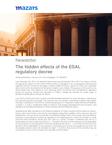
The hidden effects of the ESAL regulatory decree
Last December 20, 2017, the National Government issued Decree 2150 of 2017 by means of which the special tax regime for Non-Profit Entities (ESAL) is regulated. In an unnecessarily extensive and repetitive manner, through its 65 pages, multiple matters of the tax regime for ESALs are regulated, within which is the tax treatment of donations made to such entities. The purpose of this column is to demonstrate how, with respect to such particular point, the Government exceeded its regulatory powers by ignoring, through the regulation of ESALs, multiple tax benefits for certain types of donations introduced by the last tax reform.
Law 1819 of 2016 enshrined a special and differentiated treatment for some donations, attending to the need and importance of these. This was the case, for example, of donations made through Higher Education Institutions or ICETEX to scholarship programs or forgivable credits that benefit students of strata 1, 2, and 3, investments made in research, technological development and innovation, and donations to the National Network of Public Libraries and the National Library.
Regarding the latter (donations to the National Network of Public Libraries and the National Library), the tax reform went further, and not only innovated by saying that in addition to the maximum discount established in the law, donors would also be entitled to deduct 100% of the actual value donated for purposes of calculating the income tax payable for the taxable period in which the donation is made and that these donations would give "the right to a Library Donation Certificate that will be a transferable security to order by the donor (...)" and that "the amount of the donation will be deductible for the purposes of calculating the income tax payable by the donor (...)" and that "the amount of the donation will be deductible for the purposes of calculating the income tax payable by the donor for the taxable period in which the donation is made". )" and that "the amount of the incentive may be amortized in a term of five (5) years from the date of the donation".
This innovation in the sum of tax benefits (deduction + discount + freely negotiable security and amortizable in 5 years), which undoubtedly would considerably encourage donations that would be received by the National Network of Public Libraries and the National Library, seems to have been "annulled" or "repealed" with the issuance of the recent Decree 2150 of 2017. The above, in view of the fact that such decree establishes, in its article 1.2.1.1.4.1. that "donations made (...) may only be subject to the tax discount", in its article 1.2.1.1.4.3. that "the value certified by the donating entity (...) may only be used by the donor", and, in its article 1.2.1.1.4.5. that "the tax discount must be requested in the tax return (...) of the taxable year in which the donation was made".
From the reading of the decree, and except for the specific exceptions that it makes, for example, for the research, technological development and innovation sector, it would be understood that there would be no concurrence of tax benefits (discount and deduction) and that the aforementioned security would lose its raison d'être since it could only be used by the donor in the period in which the donation was made.
The regulatory power of the President, as established in numeral 11 of article 189 of the Political Constitution, is limited to effectively regulate the law and not to exceed it, annul it or tacitly repeal it. It is not really understood how such interesting tax benefits can be created for the promotion of an activity that is basic and inherent to human growth (reading) and then be erased with the stroke of a pen.


